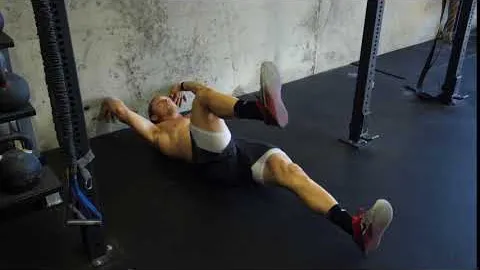
The Wall Deadbug exercise is a highly effective core strengthening exercise that targets the muscles in the abdomen, lower back, and hips. It is a popular choice among fitness enthusiasts, athletes, and physical therapists due to its ability to activate and strengthen the deep stabilizing muscles of the core.
Initial Position: Start by lying on your back with your legs bent at a 90-degree angle and your feet resting flat against a wall. Your knees should be positioned directly above your hips, creating a tabletop position with your legs.
Engage Your Core: Gently press your lower back into the floor, engaging your abdominal muscles. This will help stabilize your spine throughout the exercise.
Arm Position: Extend your arms straight up toward the ceiling, so that they are perpendicular to your body.
Begin the Movement: Slowly lower one leg toward the ground by straightening your knee, while simultaneously lowering the opposite arm overhead toward the floor. Keep your lower back pressed into the floor throughout this movement to provide support to your spine.
Return to Initial Position: Exhale as you bring your extended leg and arm back up to the starting position, maintaining control and engaging your core muscles.
Alternate Sides: Repeat the movement with the opposite leg and arm, ensuring a slow and controlled motion.
Repetitions: Perform 10 to 12 repetitions on each side, for a total of 20 to 24 repetitions.
Core Strength: The primary benefit of the Wall Deadbug exercise is its ability to target and strengthen the muscles of the core. This includes the rectus abdominis, obliques, transverse abdominis, and erector spinae, which play a vital role in stabilizing the spine and maintaining proper posture.
Improved Stability: By engaging the deep stabilizing muscles of the core, the Wall Deadbug exercise helps improve overall stability and balance. This can be particularly beneficial for athletes involved in sports that require dynamic movements and quick changes in direction.
Injury Prevention: Strengthening the core can help prevent injuries, especially those related to the lower back. By stabilizing the spine, the Wall Deadbug exercise can reduce the risk of strain or sprain in the lumbar region, making it an essential exercise for individuals with a history of back pain or those looking to prevent future issues.
Enhanced Athletic Performance: Core strength is fundamental for athletic performance in various sports, such as running, cycling, and weightlifting. By incorporating the Wall Deadbug exercise into your training routine, you can improve your overall athletic performance and potentially enhance your speed, power, and endurance.
Start Slow: If you are a beginner or have a weak core, start with fewer repetitions and progressively increase as you become more comfortable and stronger.
Maintain Control: It is crucial to maintain control throughout the exercise. Do not rush the movement or sacrifice form for quantity. Quality of movement is more important than quantity.
Avoid Excessive Lower Back Arching: Be mindful to keep your lower back pressed into the floor throughout the exercise. Avoid excessive arching, which can strain your lower back and reduce the effectiveness of the exercise.
Modify the Range of Motion: If you are unable to fully extend your leg or arm without losing control or compromising your lower back position, reduce the range of motion until you can perform the exercise correctly.
The Wall Deadbug exercise can be performed as part of a core workout or as a standalone exercise. Here are a few ways you can incorporate it into your routine:
Core Circuit: Perform the Wall Deadbug exercise in conjunction with other core strengthening exercises, such as planks, Russian twists, and bicycle crunches. Complete 2 to 3 sets of each exercise, resting for 45 to 60 seconds between sets.
Dynamic Warm-up: Use the Wall Deadbug exercise as part of your dynamic warm-up routine to activate your core muscles and prepare your body for more intense exercises or activities.
Rehabilitation: Physical therapists often utilize the Wall Deadbug exercise to strengthen the core muscles of individuals recovering from back injuries. Follow the guidance of your healthcare professional for a personalized rehabilitation program.
The Wall Deadbug exercise is a highly effective movement for developing a strong and stable core. By incorporating this exercise into your workout routine, you can improve your core strength, enhance stability, prevent injuries, and potentially boost your athletic performance. Remember to prioritize proper form and gradually increase the intensity of the exercise as your strength improves.
If you're looking for a gym, fitness club or yoga studio, you've come to the right place.
You can find information about gyms in your area. Browse catalog of gyms and find gyms with classes which are you looking for.
On gym page you can find simple information like address, phone or website. You can find list of available classes. You can check availability of personal training or small group classes. On place page you can also see information about open hours.
You can find gyms near you with amenities, courts, studios and equipments.
Use our map to find gym at your city or district.
In Gym Navigator you can find list of exercises with movies for many body parts.
You can browse exercises catalog and find exercises the best of you.
You can also find exercises grouped into workout plans, which you can use to improve you body. Each routine show you exercises one by one and give you possibility to count you progress and count down rest time.